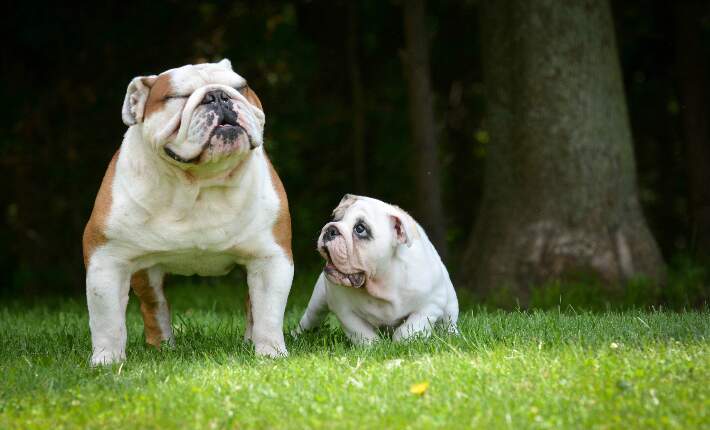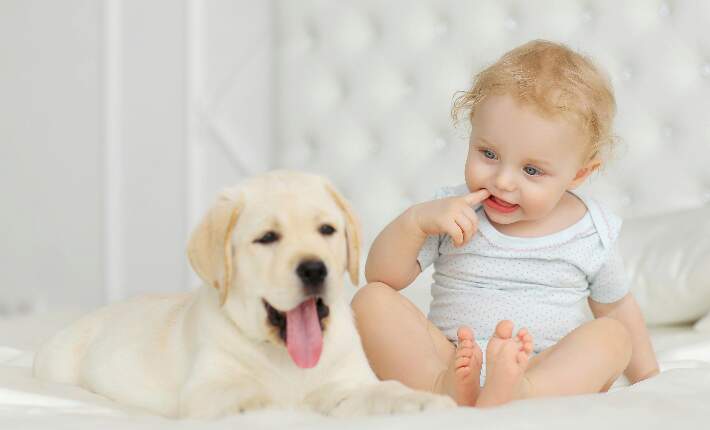10 True (and Adorable) Puppy Facts
When you think of puppies, you most likely picture cute little fluffballs with eyes you just can't resist. But beyond their adorableness, there are many fascinating tidbits to learn about these amazing furry friends. From their biological features to simply why they're called "puppies," we compiled 10 of the most interesting puppy facts!
#1: Puppies Are Born Underdeveloped…and There's a Reason Why

Unlike humans, dogs are typically pregnant for about two months. This shorter gestation period is a result of evolution; in the wild, a pregnant dog could not catch fast prey and contribute to the pack. Therefore, as dogs evolved, the less time they spent pregnant—and the faster they could get back to hunting, according to Psychology Today.
Because puppies spend such a brief time in their mother's womb, they are born underdeveloped—blind, deaf, and without teeth. While their senses of touch and smell arrive once they are born, pups open their eyes and ears around two weeks. By three weeks, puppies' baby teeth begin to come in, according to the Veterinary Centers of America Inc.
#2: Puppies Learn Life Lessons from Their Moms (and Littermates!)

Puppies learn a significant amount from their mothers—especially at about five weeks old during the weaning process. Mothers will snap or growl at unacceptable behavior to teach their puppies the proper way to behave. (It turns out even dogs show their offspring a little "tough love"!)
Plus, this essential discipline and communication help puppies learn obedience, which often makes training easier in the future. Through interaction with their littermates, puppies learn social skills that will come in handy when meeting people and other pets.
#3: Training Can Begin as Soon as You Bring a Puppy Home

Puppies can begin to learn basic dog obedience commands such as, "sit," "down," and "stay" at just seven to eight weeks old (which is typically the age pet parents can welcome a new pup home), according to PetMD. Because puppies have short attention spans at this young age, the training sessions should be brief daily occurrences with positive reinforcement.
In addition to teaching commands around seven to eight weeks, you can also start leash training a puppy. However, it is important to note to stay indoors while doing this because puppies don't have all their full vaccinations at this age.
#4: The Word "Puppy" Has French Roots

The term "puppy" originated from the French word "poupeé"—which means "doll" or "toy"— and entered the English language in the late 1500s. Before that, "whelps"—a German word of unknown origins—was the term used to describe these little furry friends, according to the Online Etymology Dictionary. William Shakespeare's King John is the first known work to reference "puppy."
#5: Puppies Spend Most of the Day Snoozing

Like babies, puppies spend a lot of time sleeping—about 15 to 20 hours of the day! Pups are growing, learning about their new worlds, and exercising with you daily, so it makes sense they need plenty of rest.
Pups tend to take naps after meals or playtime, and of course, they sleep through the night when everyone else in the family goes to bed. A designated cozy spot is especially important because undisturbed sleep is key for puppies' brain, muscle, and immune system development.
#6: Different Breeds Have Different Litter Sizes

Typically, larger breeds have larger litters and smaller breeds have smaller litters. This is due to biological reasons; the bigger the dog, the more puppies they can hold in their womb and vice versa.
On average, litter sizes usually range from about one to 12 pups. However, in 2004, a Neapolitan Mastiff gave birth to 24 puppies in Cambridgeshire, UK—making it the largest litter ever recorded, according to Guinness Book of World Records.
#7: Puppies Can Be Identical Twins

Although puppy siblings often look similar, the first set of identical puppy twins wasn't confirmed until recently. In 2016, a South African veterinarian performed a C-section on an Irish Wolfhound and discovered two of the seven puppies in the litter shared a placenta. DNA testing later found that these puppies were in fact identical twins, according to the British Broadcasting Corporation (BBC).
#8: Puppies' Coats Change with Age

Another fun puppy fact is their coat color or pattern could change over time! This is because puppies are born with a single layer of soft fur. Once they shed that layer around four to six months old, their thicker adult coat develops—and this coat could be darker, lighter, or even display new spots or specks.
One breed that is particularly known to have a significantly different coat as an adult is the Dalmatian. These puppies are born white and spotless, acquiring spots as they get older, according to the American Kennel Club (AKC).
#9: All Puppies Are Born Blue-Eyed Beauties

Because their eyes lack melanin—the pigment that determines eye color—puppies are born with blue eyes. While some puppies will retain the blue eye color for life, other pups' eyes will begin to show hints of their permanent color at around three to four weeks of age. It could take as long as three months for the color to fully develop, according to Petsoid.
#10: There's Science Behind Puppies' Cuteness

One theory explaining why we think pups are so adorable is known as the "baby schema" effect. This theory suggests that when we look at puppies (and babies), oxytocin and dopamine, or "happy hormones," are released in our brains. These chemicals are triggered by seeing physical features such as puppies' big eyes, large head compared to their bodies, and soft skin and coats. In turn, this makes us subliminally admire and want to take care of puppies, according to National Geographic.
Who knew these little companions could be even more interesting than you already thought? Now that you have learned these fun facts about puppies, take this Pup Quiz to test your knowledge!
FOLLOW US!





